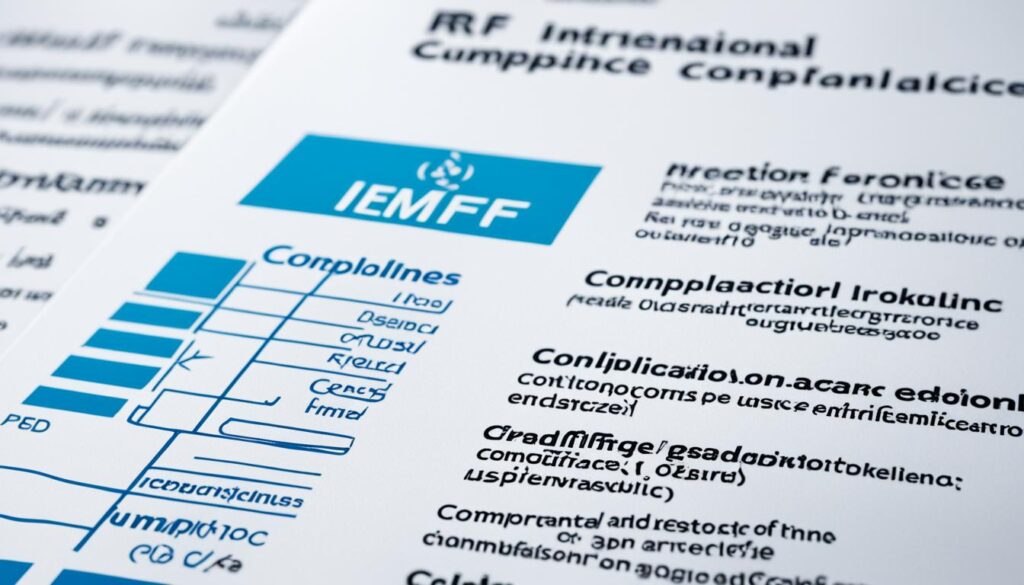Disclosure: This Post Contains Affiliate Links; We earn a commission on purchases.
Welcome to our guide on compliance with EMF (Electromagnetic Field) regulations and best practices for businesses. As the use of EMF technologies continues to grow, it is crucial for businesses to prioritize regulatory compliance, ensuring the health and safety of employees and the general public.
Adopting key principles and good practice policies not only supports efficient assessment and management of RF-EMF exposure compliance for mobile network sites but also demonstrates a commitment to meeting regulatory standards. Compliance with EMF regulations is essential for businesses operating in various industries, from telecommunications to electronics manufacturing.
Key Takeaways:
- Compliance with EMF regulations is crucial for businesses to meet regulatory standards and safeguard health and safety.
- Adopting key principles and good practice policies supports efficient assessment and management of RF-EMF exposure compliance.
- Businesses should ensure they comply with international RF-EMF guidelines and follow administrative good practices.
- Implementing best practices for site RF-EMF compliance is essential for maintaining regulatory compliance and protecting employees and the public.
- Businesses play a vital role in promoting a safe and responsible use of EMF technologies.
RF-EMF Compliance for Networks
When it comes to RF-EMF compliance for networks, following the appropriate exposure limits and compliance standards is crucial. The basis for national policy in this regard should be the International Commission for Non-Ionizing Radiation Protection (ICNIRP) guidelines, which provide recommended human exposure limits. In order to ensure compliance, it is important to rely on methods outlined in international technical standards produced by the International Electrotechnical Commission (IEC) and the International Telecommunications Union (ITU).
There are two main approaches to RF-EMF compliance in national regulatory practices: declaration-based and permit-based. The declaration-based approach involves operators conducting self-assessment of compliance, while the permit-based approach requires operators to submit a compliance file and may involve a third-party assessment.
“Operator declaration reduces administrative burden and allows for more efficient network deployment.”
By allowing operators to declare compliance, regulatory authorities can streamline the process and expedite network deployment, leading to increased efficiency.
To reinforce the idea of operator declaration, here is a visual representation that highlights the advantages it offers:
| Declaration-Based Approach | Permit-Based Approach |
|---|---|
| – Operator self-assessment | – Compliance file submission |
| – Reduced administrative burden | – Third-party assessment |
| – Efficient network deployment | – Increased assessment complexity |
As illustrated in the table, the declaration-based approach reduces administrative burden, allowing operators to assess compliance efficiently and expedite network deployment. This approach aligns with best practices and supports the responsible use of RF-EMF technologies.
Adopt International RF-EMF Guidelines
When it comes to managing RF-EMF exposure, countries should look to the internationally recognized guidelines developed by the International Commission for Non-Ionizing Radiation Protection (ICNIRP). These guidelines are based on the latest scientific evidence and provide reference levels for general public exposure that ensure compliance with the basic restrictions.
If national regulatory authorities want to establish effective compliance standards, it is crucial for them to adopt these guidelines. The ICNIRP Guidelines offer comprehensive tables that outline the reference levels for general public exposure, providing clear guidance for regulatory authorities to follow in their compliance efforts.

Furthermore, it is recommended that national regulatory authorities consider adopting the 2020 version of the guidelines once the relevant standards explaining the methodology for assessing compliance have sufficiently progressed. By aligning with the latest international guidelines, countries can ensure a consistent approach to RF-EMF exposure management and protect the health and safety of their citizens.
FCC Policy on Human Exposure to RF Electromagnetic Fields
Ensuring the safety of human exposure to RF electromagnetic fields (RF-EMF) is a key concern for the Federal Communications Commission (FCC). By evaluating the effect of emissions from FCC-regulated transmitters on human health, the FCC aims to protect the general public from potential safety hazards associated with RF-EMF exposure.
The FCC has adopted the recommended Maximum Permissible Exposure (MPE) limits for field strength and power density, as recommended by the National Council on Radiation Protection and Measurements (NCRP). These limits serve as a guideline for establishing safe levels of RF-EMF exposure.
The detailed requirements for RF safety can be found in Parts 1 and 2 of the FCC’s Rules and Regulations. The FCC closely follows the guidelines and recommendations provided by esteemed organizations such as the American National Standards Institute (ANSI), the Institute of Electrical and Electronics Engineers (IEEE), and the NCRP.
With a focus on ensuring compliance with RF safety rules, the FCC’s policies aim to protect the general public from any potential health risks associated with RF-EMF exposure. The FCC also provides valuable information and guidance on RF safety through its frequently asked questions (FAQ) section.
“Our priority is to safeguard the well-being of the public by setting and enforcing standards to minimize any potential health risks associated with RF-EMF exposure,” said an FCC representative.

In the constantly evolving landscape of technology, it is crucial to establish and enforce policies that prioritize the safety of human exposure to RF electromagnetic fields. The FCC remains committed to its mission of promoting the responsible use and regulation of RF-EMF technologies to protect the well-being of the general public.
Conclusion
Compliance with EMF regulations is crucial for businesses to meet regulatory standards and ensure the health and safety of their employees and the public. By adopting the key principles and good practice policies outlined, businesses can efficiently assess and manage RF-EMF exposure compliance for mobile network sites.
It is imperative for businesses to comply with international RF-EMF guidelines and follow administrative good practices. Implementing the best practices for site RF-EMF compliance allows businesses to prioritize regulatory compliance and contribute to the safe and responsible use of EMF technologies.
By prioritizing compliance practices, businesses not only protect themselves from potential legal issues but also demonstrate their commitment to the well-being of their employees and the wider community. Adhering to the regulatory standards ensures a safer and healthier environment for everyone.
Source Links
- https://www.fcc.gov/general/radio-frequency-safety-0
- https://www.gsma.com/publicpolicy/wp-content/uploads/2021/10/GSMA_EMF_Exposure_Compliance_Policies_for_Mobile_Network_Sites_Oct21.pdf
- https://www.ofcom.org.uk/__data/assets/pdf_file/0025/214459/guidance-emf-compliance-enforcement.pdf

Subscribe to Our Newsletter










